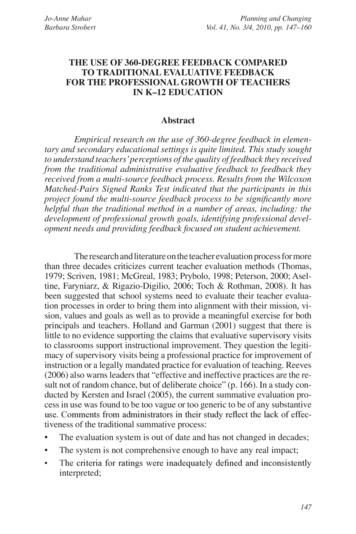
Transcription
Jo-Anne MaharBarbara StrobertPlanning and ChangingVol. 41, No. 3/4, 2010, pp. 147–160The Use of 360-Degree Feedback Comparedto Traditional Evaluative Feedbackfor the Professional Growth of Teachersin K–12 EducationAbstractEmpirical research on the use of 360-degree feedback in elementary and secondary educational settings is quite limited. This study soughtto understand teachers’ perceptions of the quality of feedback they receivedfrom the traditional administrative evaluative feedback to feedback theyreceived from a multi-source feedback process. Results from the WilcoxonMatched-Pairs Signed Ranks Test indicated that the participants in thisproject found the multi-source feedback process to be significantly morehelpful than the traditional method in a number of areas, including: thedevelopment of professional growth goals, identifying professional development needs and providing feedback focused on student achievement.The research and literature on the teacher evaluation process for morethan three decades criticizes current teacher evaluation methods (Thomas,1979; Scriven, 1981; McGreal, 1983; Prybolo, 1998; Peterson, 2000; Aseltine, Faryniarz, & Rigazio-Digilio, 2006; Toch & Rothman, 2008). It hasbeen suggested that school systems need to evaluate their teacher evaluation processes in order to bring them into alignment with their mission, vision, values and goals as well as to provide a meaningful exercise for bothprincipals and teachers. Holland and Garman (2001) suggest that there islittle to no evidence supporting the claims that evaluative supervisory visitsto classrooms support instructional improvement. They question the legitimacy of supervisory visits being a professional practice for improvement ofinstruction or a legally mandated practice for evaluation of teaching. Reeves(2006) also warns leaders that “effective and ineffective practices are the result not of random chance, but of deliberate choice” (p. 166). In a study conducted by Kersten and Israel (2005), the current summative evaluation process in use was found to be too vague or too generic to be of any substantiveuse. Comments from administrators in their study reflect the lack of effectiveness of the traditional summative process: The evaluation system is out of date and has not changed in decades; The system is not comprehensive enough to have any real impact; The criteria for ratings were inadequately defined and inconsistentlyinterpreted;147
MaharStrobert Although a district-wide process is in place, it does not yield anymeaningful feedback for teachers [italics added]. (p. 58)Danielson and McGreal (2000) identified six main deficienciesin current teacher evaluation systems: a) they utilize outdated, limited,evaluative criteria; b) they indicate few shared values and assumptionsabout good teaching; c) they lack precision in evaluating performance; d)they are hierarchical one-way communication; e) there is no differencebetween novice and experienced practitioners; and f) they are conductedwith limited administrator expertise. As school districts develop committees to improve their teacher evaluation systems, Danielson and McGrealrecommend they focus their discussions on:1. Those practices that are realistic for the district in terms of teacher andadministrator time demands.2. The availability of resources to support the training necessary to makenew systems function effectively.3. The level of commitment that the administration, the board of education, and the teachers union have to break away from more traditionalviews of evaluation. (p. 17)Danielson and McGreal go on to mention the potential benefits offeedback from parents, teachers, and colleagues in this process. In a studyconducted in Nevada, Sawyer (2001) found that teachers complained thatthere was no collaboration and their evaluation process provided them withvery little productive feedback. King (2003) suggested that K–12 schooldistricts need to break away from traditional views of teacher evaluationby reviewing the research and literature and providing teachers with moreoptions within this process. Included in her recommendations are such options as professional growth plans based on measurable goals, peer reviewand coaching, professional portfolios and the use of 360-degree feedbackprocess in the development of professional growth goals.The idea that teachers’ performance evaluations should be builtupon multiple data sources is supported in Koçak (2006), Douglas &Douglas (2006), Marzano (2003), Danielson & McGreal (2000), andGray-Smith (2000). Danielson and McGreal recognize the value of 360degree feedback systems as a data collection option in the teacher evaluation process. The 360-degree feedback is a contemporary feedback strategy focused on building professional growth. The 360-degree feedbackprocedure relies upon feedback from peers, subordinates, supervisors, andothers within the evaluatee’s circle of involvement. The intent is to linkfeedback received to the organization’s goals and initiatives and to the employee’s professional career development.For 20 years, research has shown that 360-degree feedback canenhance communications and performance when the employee is held accountable to develop a professional growth plan in line with the organiza148Planning and Changing
The Use of 360-Degree Feedbacktion’s mission, vision, values, and goals (Bernadin & Beatty, 1987). Schoolsmight also experience similar results if the 360-degree feedback process isoffered as an option for the annual performance review of teachers. Thisstudy explores the possibility that K–12 teachers can also benefit from receiving feedback from more than one source, which has traditionally beenthe administrator. This might include feedback from multiple sources suchas students, parents, and colleagues as well as the administrator.Student ratings of teachers show the strongest positive relationshipto student achievement when compared with those of principals and teachers (Wilkerson, 1997; Manatt & Kemis, 1997; Manatt & Benway, 1998;Koçak, 2006). This is also corroborated by Peterson (2000), who foundthat data from student surveys and questionnaires can be highly reliabledue to the large numbers of students as reporters. Manatt suggested that ifthe feedback process is done right, it can be the foundation for school transformation efforts.There is very little research on the use of the 360-degree feedbackprocess in K–12 public education. There have been several recommendations suggesting further study of this process in schools, as it may be another viable option for districts to consider for the professional growth ofteachers toward student achievement. This study tested this theory by replicating previous studies conducted at the Research Institute for Studies inEducation (RISE) at Iowa State University.Methods and ProceduresThis descriptive study utilized a non-experimental, quantitative andqualitative survey design to compare teachers’ experiences with the traditional single-source feedback obtained from the summative annual performance review process to the feedback obtained from the 360-degree feedback process. A qualitative analysis was conducted by analyzing the openended statements included on all surveys. A quantitative analysis was conducted based upon the responses obtained from the pre- and post-study surveys completed by teachers participating in this pilot project. The researchdesign and methodology had several limitations and delimitations: a) thisstudy was confined to one suburban school district in the state of New York,therefore the results could not be generalized to any other group; b) teachersurvey responses were representative of their individual experiences withtraditional evaluative feedback compared to their personal experiences withthe 360-degree feedback process. As with many survey studies, the returnrate limited the amount of feedback obtained for teacher use.SampleThis pilot project took place in a large suburban district in the central Hudson Valley region of New York State, which is representative ofVol. 41, No. 3/4, 2010, pp. 147–160149
MaharStrobertother New York State suburban school districts. In this district, there arenine elementary schools, three middle schools and one high school, witha total population of slightly more than 10,000 students and 786 teacherscurrently employed in grades K–12. Twelve initial volunteers were selected by a random sampling method. A table of random numbers was used(Witte & Witte, 2007) to identify the first 12 participants from the districtdata base of personnel. This was stratified by gender and grade level. Afterthe first 12 participants completed the process, 15 additional participantsvolunteered to participate. A total of 27 teachers from grades K–12 completed the process during the 2007–2008 school year. Table 1 shows thepercentage of participants by assignment area.Table 1Percentage of Participants by Assignment AreaGrade 12414.8aOtherTotal27.42799.9Note. This percentage has been rounded and therefore the total is less than 100%.Other teaching staff participating included special education, remedial, or speech teachers.aInstrumentationAll surveys and the resulting data sets obtained for this study wereprovided by the Research Institute for Studies in Education (RISE) at IowaState University. Participating teachers completed electronic pre- andpost-study questionnaires comparing 360-degree feedback, the independent variable, with traditional single-source evaluative feedback (GraySmith, 2000). All surveys utilized a Likert scale for responses: 1 StronglyAgree, 2 Agree, 3 Disagree, 4 Strongly Disagree. Teachers responded to 14 statements that were focused on obtaining their perceptions of thequality of feedback they receive from the current, single source evaluationmethod (pre-study survey) and the quality of feedback they receive fromthe 360-degree method (post-study survey). These dependent variables included fourteen identical statements on both pre- and post-study surveysthat sought to elicit participants’ responses indicating how each systemprovides: a) feedback on the effective performance of job responsibilities;b) feedback that promotes professional growth; c) feedback to guide futureprofessional development; d) reports that are practical for the improve150Planning and Changing
The Use of 360-Degree Feedbackment of job performance. One additional statement was added to the poststudy survey: “the 360-degree process enhances the traditional system.”This project also utilized Teacher-to-Teacher feedback questionnaires containing 13 items, Parent-to-Teacher feedback questionnaires containing 25 items, and Student-to-Teacher feedback questionnaires containing 20 items. The majority of the items adopted for use on the feedbackinstruments were selected from the pool of valid, reliable, and legally discriminating items identified in previous studies. The findings of previousresearch conducted by refining the survey questionnaires were accepted forthe purpose of this study (Omatoni, 1992; Weber, 1992; Wilcox, 1995; andWilkerson, 1997).ProceduresThe pre-study survey for participating teachers was posted electronically using surveymonkey.com. Participants were given a seven daywindow to complete the survey.Parents were chosen randomly from each teacher’s student rosterand were sent confidential survey packets including the Parent-to-Teachersurvey and a self addressed, stamped envelope for return. Students of participating teachers completed the Student-to-Teacher surveys under the supervision of district support staff (guidance counselors, social workers or schoolpsychologists) after obtaining parental permission. Participating teacherswere not present during student survey administration. Colleagues of participating teachers were randomly chosen and sent a confidential Teacherto-Teacher survey packet for completion. Parents and colleagues were givena 10-day window to complete and return the surveys. All returned surveypackets were then sent to the RISE consultant at Iowa State University fordata processing. The participating teachers were provided with the parent,student, and colleague feedback results in a booklet format from the RISEconsultant. All results were completely confidential and provided only tothe participating teachers. Participants were given a two week time periodto reflect upon these results before completing a post-study electronic survey based on their experiences with the 360-degree feedback process.Data AnalysisAnalysis was performed using SPSS for Windows Version 17.0.Since the population sample size was relatively small (n 27), the Wilcoxon Signed Rank Test was used to determine if the difference betweenthe pre-study questionnaire and post-study questionnaire scores are greater than would occur by chance: Z the smaller of R or R-. The Wilcoxonsigned-rank test is a non-parametric test of two related samples on a singlesample. It is an appropriate measure when the dependent variables are ordinal and samples are related as in this study.Vol. 41, No. 3/4, 2010, pp. 147–160151
MaharStrobertA T-test for Paired Samples also provided a comparison of differences between the pre- and post-measurements. This test was performedto compare the means from the survey results of the traditional method tothe survey results of the 360-degree feedback method and to determine ifthere is a significant difference between the means, or if the differences aredue to sampling errors created by random sampling.FindingsThe purpose of this study was to gain knowledge of the use of the360-degree feedback method in K–12 education and to determine if thismethod of feedback is effective in assisting teachers when developing professional growth goals and identifying professional development needs.Results from this 360-degree feedback pilot study were analyzed to answer the following research questions: To what extent does the traditional single-source feedback method ofevaluation provide useful feedback to teachers? To what extent does the 360-degree feedback model provide usefulfeedback to teachers? To what extent does the 360-degree feedback model compare to thetraditional single-source feedback model in assisting teachers in developing professional growth goals? To what extent does the 360-degree feedback model compare to thetraditional single-source feedback model in assisting teachers in developing professional development needs?The Traditional MethodThere were no positive comments offered regarding the type offeedback received from the traditional method from the pre-study survey.The teacher participants reported that the traditional method is not effective in providing feedback related to their daily work. Respondents indicated that a shortcoming of the traditional method is that it provides littleguidance toward instructional improvement, and administrator feedbackis vague. They find the processes to have little relevance or impact ontheir educational practice, and they receive many irrelevant and positiveevaluations. In other words, the participants in this study agree with Peterson (2000) that the vast majority of teachers find the feedback from traditional observation checklists less than professionally meaningful, and theyagree with Aseltine et al. (2006), who also contend that this method rarelyhelps teachers make a direct link with their professional growth and student learning needs. Most disconcerting is that only 29.6% of the participants find the traditional method to be focused on student achievement.152Planning and Changing
The Use of 360-Degree FeedbackThe 360-degree Feedback MethodThe most frequent complaint about the 360-degree process fromparticipants was the lack of responses from colleagues and parents, whichwas indicated in Tables 2 and 3.Table 2Teacher-to-Teacher Feedback by Grade LevelGrade levelSentReturned% ther teaching staff participating included special education, remedial, or speech teachers.Table 3Parent-to-Teacher Feedback by Grade LevelGrade levelSentReturned% ther teaching staff participating included special education, remedial, or speech teachers.Another issue that surfaced was that some of the survey statements wereinappropriate for a particular respondent, for example: “My teacher givesappropriate homework.” Some teachers do not give homework; thereforethey believe this statement not to be helpful. A final criticism was the factthat having an outside agency involved with the process made the processslower than might have occurred if surveys were not sent out of districtfor processing.Several positive comments about the 360-degree process werenoted. Respondents generally liked the process and found that the feedback contained in the final report was quite helpful, especially the studentsurvey results. This supports the findings of Peterson, Wahlquist, Bone,Thompson and Chatterton (2001) and Wilkerson, Manatt, Rogers, andVol. 41, No. 3/4, 2010, pp. 147–160153
MaharStrobertMaughan (2000) claiming that data from student surveys and questionnaires can be highly reliable due to the large numbers of students as reporters, as indicated on Table 4. It was noted that the process offered someclear areas that can assist teachers with improvement.Table 4Student Feedback by Each Grade LevelGrade levelTeacher participantsStudent therTotal21327529Percentage total student return100aOther teaching staff participating included special education, remedial, or speech teachers.ComparisonsTable 5 presents the means, t-scores, degrees of freedom and significance level of each of the survey items.Table 5Paired Samples T-testMtdf2-tailsignificance1a. The promotion of sound educational principles.2301.29625.2071b.The effective performance of job responsibilities.3602.09224.047*1c. The fulfillment of district and school goals.160.89124.3821d.The promotion of professional .110Feedback Criteria2a. The identification of strengths and concerns2b.The performance of job responsibilities2c. The guide to future professional development.4612.48325.020*3a. The creation of reports for the improvement ofjob performance.4232.39125.025*3b.The identification of strengths.120.56924.5743c. The identification of weaknesses.115.64725.5233d.The job responsibilities of the person evaluated.4231.89725.0694a. The focus on teacher behaviors.4162.84623.009*(continued)154Planning and Changing
The Use of 360-Degree FeedbackTable 5 (continued)Mtdf2-tailsignificance4b.The focus on student behaviors.5452.80621.011*4c. The focus on student achievement.6662.43623.023*Feedback Criteria* Significant at the .050 level.There was a significant difference between the means of the pre-study andpost-study survey on eight of the fourteen survey statements. The 360-degree feedback model proved to be significantly better than the traditionalmodel on the following criteria:1. The effective performance of job responsibilities.2. The promotion of professional growth.3. The guide to future professional development.4. The creation of reports for the improvement of job performance.5. The job responsibilities of the person evaluated.6. The focus on teacher behaviors.7. The focus on student behaviors.8. The focus on student achievement.The differences on the remaining six criteria were found not to be statistically significant.The Wilcoxon Matched-Pairs Signed-Ranks Test indicated the360-degree feedback model provided participants with more actionablefeedback than the traditional feedback model as indicated in Table 6.Table 6Wilcoxon Matched-Pairs Signed-Ranks TestFeedback CriteriaMean e promotion of sound educationalprinciples7.5/9.1-1.29.1961b.The effective performance of job responsibilities6.5/7.1-2.00.046*1c.The fulfillment of district and school goals1d.The promotion of professional growth5.8/6.07-.884.3776.0/7.9-2.29.022*2a.The identification of strengths and concerns8.7/9.4-1.03.3022b.The performance of job 2c.The guide to future professional developmentVol. 41, No. 3/4, 2010, pp. 147–160(continued)155
MaharStrobertTable 6 (continued)Feedback CriteriaMean e creation of reports for the improvement of job performance7.0/9.0-2.20.027*3b.The identification of strengths6.4/6.5-.566.5713c.The identification of weaknesses8.2/7.8-.646.5183d.The job responsibilities of the personevaluated8.8/7.7-1.99.046*4a.The focus on teacher behaviors.00/4.0-2.42.015*4b.The focus on student behaviors4c.The focus on student achievement4.5/6.9-2.44.015*11.6/9.5-2.01.044** Significant at the .050 level.The difference in all of these ranks is negative, which indicates that thepost-test scores (360-degree feedback), are ranked higher than the pre-testscores (traditional single-source feedback model).The 360-degree feedback method was found to be significantlymore effective in providing feedback that promotes professional growth,z -2.29, p 022. This finding supports the work of Grey-Smith (2000),who found the multi-rater system provides more data than the traditionalmethod on which to base performance improvement.In the study conducted by Mabey (2001), respondents rated theirexperiences with 360-degree feedback as providing much more focusedstaff development suggestions than the traditional model. Mabey’s findings are supported in this study, since the 360-degree process was found tobe significantly better in assisting teachers in identifying professional development needs, z -2.27, p .023.Contrary to the traditional method, 66.7% of the participants foundthe 360-degree feedback process to be more focused on student achievement. This statement was found to be statistically significant on the Wilcoxon Matched-Pairs Signed Ranks Test (z -2.01, p .044). In light ofthis finding, one might conclude that the feedback obtained from the surveys provided teachers with information to improve instruction and therefore student achievement. Since the vast majority of the returned surveyswere from students, one might conclude that student feedback has an impact on instruction. This data supports the statement by Wilkerson et al.(2000): “students provide more valid feedback than teachers if studentachievement is the validity measure” (p.187). Each test is significant to the.050 level, indicating these results are not just due to chance at that level.Participants in this project were asked if the 360-degree processenhances the traditional system, and 81.5% agree that this model enhancesthe single-source traditional evaluation system. The 360-degree feedback156Planning and Changing
The Use of 360-Degree Feedbackprocess has been successful in other organizations, but little research todate is available to determine its effectiveness in K–12 education. The results of this study suggest that a 360-degree feedback option may indeedenhance the teacher annual performance review process.DiscussionThe participants in this project found the multi-source feedback process to be significantly more helpful than the traditional method in a number of areas, among them developing professional growth goals, identifying professional development needs, and focusing on student achievement.Certainly student achievement must be at the forefront of the annual performance review of teachers. Manatt and Kemis (1997) claimed the overarching purpose of teacher performance evaluation is to improve performance.Based upon the outcomes of this study, the 360-degree feedback process is aviable option for consideration as school leaders look to expand their teacherevaluation options with improved student achievement as the goal.Recommendations for PracticeFirst and foremost, universities must review education supervision courses. Many of these courses are based on the old model of supervision and do not include the study of options such as developing professional growth plans, teacher portfolios, data collection and goal setting,peer review, 360-degree feedback or a triangulation of methods.Districts seeking to improve the annual performance review ofteachers should consider utilizing several data sources, including feedbackfrom students, parents and colleagues. If the traditional observation checklist is currently being used, it should be carefully reviewed and differentiated,based on years of service, instructional level and/or content area. It shouldalso include a rubric for scoring to improve consistency between evaluatorsas well as to provide teachers with clear expectations for performance.The traditional observation check list should not be the sole method of teacher annual performance reviews. One observation per year isgrossly inadequate to guide a teacher’s professional growth. A combination of methods must be considered, and the 360-degree feedback processshould be offered as an option. District level policy makers need to employ several methods for the annual performance review of teachers; aspreviously suggested by Douglas and Douglas (2006), a triangulation ofinformation must be sought to monitor and manage the quality of education. The 360-degree feedback method has shown promise as an alternative. Evaluation methods that promote collegiality between teachers andtheir administrators, colleagues, students, and parents support a culture oflearning and professional growth.Public education policy makers need to take a serious look at the poVol. 41, No. 3/4, 2010, pp. 147–160157
MaharStrobertlitical nature of school governance in relation to school culture and teacherunions. As pointed out in the Kersten and Israel (2005) studies, “these factorscontribute to a culture that supports status quo and squashes risk-taking andinnovation” (p. 61). It is a conflict of interest when teacher unions control theevaluation process, so districts need to exercise caution when negotiating theteacher evaluation process. Policies should call for methods that differentiatebetween non-tenured teachers and tenured teachers, as well as between content area teachers and others. Districts must tie staff development directly tostudent data and professional growth plans for teachers. It is also essentialthat school district annual performance review policies describe how the district trains administrative staff in the use of good evaluation practices.School districts might want to consider discontinuing the use ofthe word “evaluation,” which suggests a top down, non-collaborative approach. “Performance review” and “annual professional growth” areamong some of the alternatives to be considered. Based upon the outcomes of this study, recommendations for using the 360-degree feedbackprocess as a collaborative option for the annual performance review ofteachers include:1. An outside agency is not necessary for the implementation of the 360degree process; however, their experience is helpful when using theprocess for the first time.2. Teachers and administrators should confer about the survey questionsto be included on all surveys.3. The administrator should also complete the confidential survey as acolleague in the process.4. Teachers and administrators should also confer to discuss professionalgrowth goals and development needs. All goals should be SMART: specific, measurable, actionable, realistic, timely (Tucker & Stronge, 2005);and the goals should be focused on student achievement.5. Teachers and administrators should occasionally confer to determineprogress toward goals.6. The summative evaluation process should be minimized and the formative processes maximized.ConclusionThe findings from this study provide insight into the use of the360-degree feedback process in the public school sector. The process hasbeen shown to provide participating teachers with reports that assist themin developing professional growth plans, guiding professional development needs and feedback that focuses on student achievement. The benefits of 360-degree feedback for improving teaching and ultimately studentachievement merits further research, piloting and implementation.158Planning and Changing
The Use of 360-Degree FeedbackReferencesAseltine, J. M., Faryniarz, J. O., & Rigazio-Digilio, A. J. (2006). Supervision for learning. Alexandria, VA: Association for Supervision andCurriculum Development.Bernadin, J. H., & Beatty, R. W. (1987). Can subordinate appraisals enhancemanagerial productivity? Sloan Management Review, 28, 63–73.Danielson, C., & McGreal, T. (2000). Teacher evaluation to enhance professional practice. Princeton, NJ: Educational Testing Service.Douglas, J., & Douglas, A. (2006). Evaluating teaching quality. Quality inHigher Education, 12(1), 3–13.Gray-Smith, L. (2000). The development and implementation of the 360degree feedback for administrators of a K–12 public school district.Unpublished doctoral dissertation, Iowa State University.Holland, P. E., & Garman, N. (2001). Toward a resolution of the crisis oflegitimacy in the field of supervision. Journal of Curriculum andSupervision, 16(2), 95–111.Kersten, T. A., & Israel, M. S. (2005). Teacher evaluation: Principals’ insights and suggestions for improvement. Planning and Changing,36, 47–56.King, L. M. (2003). Teacher perceptions of the Danielson/McGreal modelof differentiated evaluation and its impact on professional growth.Unpublished doctoral dissertation, Seton Hall University.Koçak, R. (2006). The validity and reliability of the teachers’ performanceevaluation scale. Educational Sciences: Theory & Practice, 6, 799–808.Mabey, C. (2001). Closing the circle: Participant views
The 360-degree feedback is a contemporary feedback strat-egy focused on building professional growth. The 360-degree feedback procedure relies upon feedback from peers, subordinates, supervisors, and others within the evaluatee's circle of involvement. The intent is to link


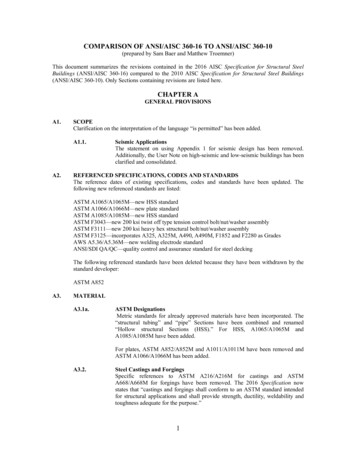
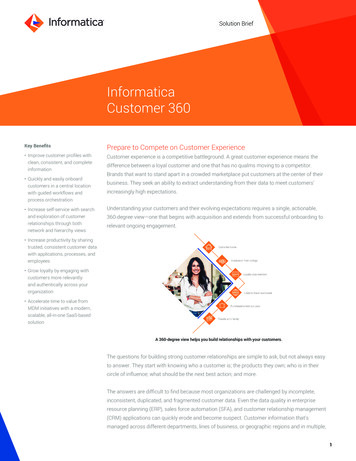

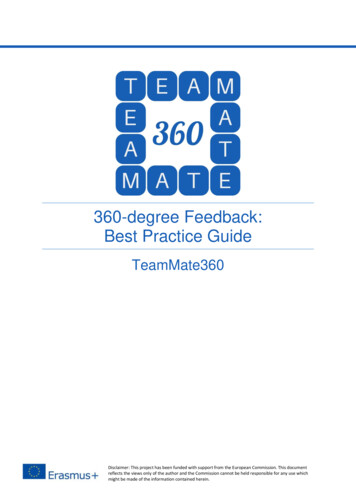
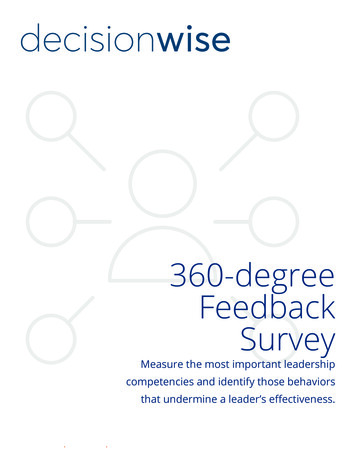

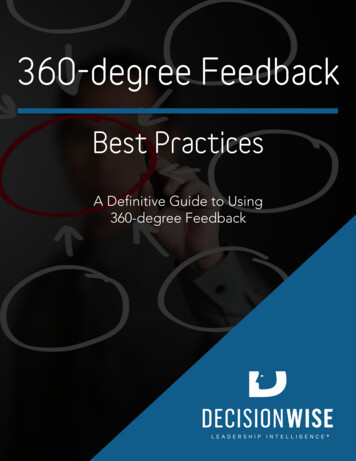
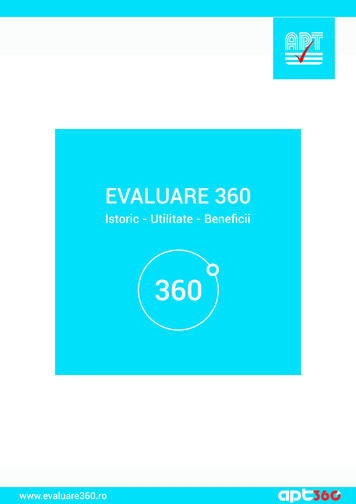
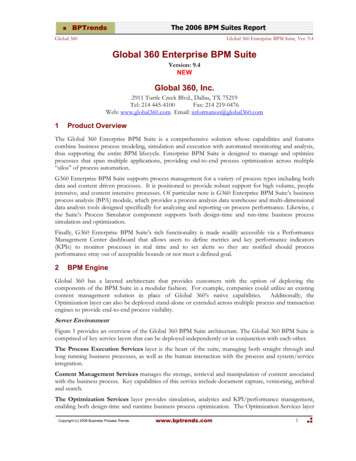
![Introducing the MDYA 360 v 2 9-10-16-1 [Read-Only]](/img/36/introducing-the-mdya-360-foltz-corrigan.jpg)